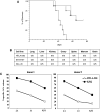Human NK cell infusions prolong survival of metastatic human neuroblastoma-bearing NOD/scid mice
- PMID: 17426969
- PMCID: PMC11030705
- DOI: 10.1007/s00262-007-0317-0
Human NK cell infusions prolong survival of metastatic human neuroblastoma-bearing NOD/scid mice
Abstract
Aim: Several lines of evidence suggest that NK cell immunotherapy may represent a successful approach in neuroblastoma (NB) patients refractory to conventional therapy. However, homing properties, safety and therapeutic efficacy of NK cell infusions need to be evaluated in a suitable preclinical murine NB model.
Materials and methods: Here, the therapeutic efficacy of NK cell infusions in the presence or absence of NK-activating cytokines have been evaluated in a NB metastatic model set up in NOD/scid mice, that display reduced functional activity of endogenous NK cells.
Results: In NOD/scid mice the injected NB cells rapidly reached all the typical sites of metastatization, including bone marrow. Infusion of polyclonal IL2-activated NK cells was followed by dissemination of these cells into various tissues including those colonized by metastatic NB cells. The early repeated injection of IL2-activated NK cells in NB-bearing NOD/scid mice significantly increased the mean survival time, which was associated with a reduced bone marrow infiltration. The therapeutic effect was further enhanced by low doses of human recombinant IL2 or IL15.
Conclusion: Our results indicate that NK-based adoptive immunotherapy can represent a valuable adjuvant in the treatment of properly selected NB patients presenting with metastatic disease, if performed in a minimal residual disease setting.
Figures






References
-
- Brodeur GM, Maris JM. Neuroblastoma. In: Pizzo PA, Poplack DG, editors. Principles and practice of pediatric oncology. Philadelphia: Lippincott–Raven; 2001. pp. 895–937.
-
- Carlsen NL, Castel V, Castelberry RP, De Bernardi B, Evans AE, Favrot M, Hedborg F. Revisions of the international criteria for neuroblastoma diagnosis, staging, and response to treatment. J Clin Oncol. 1993;11:1466–1477. - PubMed
-
- Maris JM, Matthay KK. Molecular biology of neuroblastoma. J Clin Oncol. 1999;17:2264–2279. - PubMed
Publication types
MeSH terms
Substances
LinkOut - more resources
Full Text Sources
Other Literature Sources
Medical

